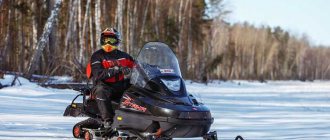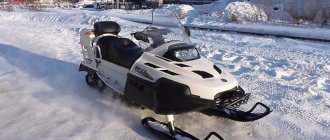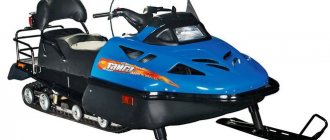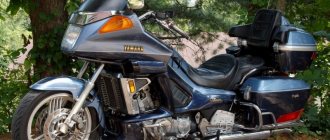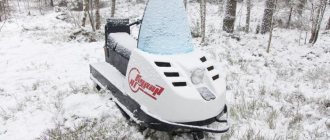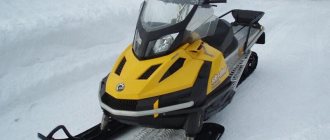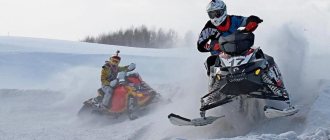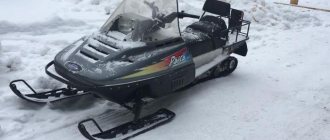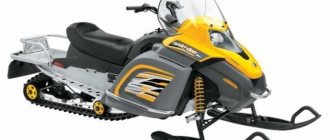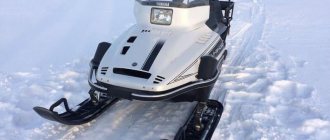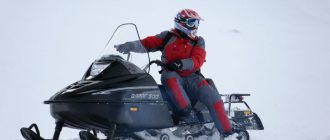A snowmobile is a popular vehicle for winter use, an excellent device for outdoor activities, fishing and hunting. It drives on snowy roads without any problems. With its help you can overcome slopes and snowdrifts, and ride in deep snow. Snowmobiles are not just for fun. The machines are also capable of performing purely practical tasks, for example, transporting people and cargo.
In order to successfully select a model for specific purposes, you need to understand what types of machines there are, how they are designed, and how different types of equipment differ.
Snowmobile device
A snowmobile is a type of motor vehicle that is used to move on ice and snow. He rides on tracks. At the front of the structure there are skis that give the car the desired direction. Previously, vehicles were equipped with rubber tracks. The new models are equipped with more practical and durable belts made from composite materials. The body is usually aluminum, steel or fiberglass. The performance of the snowmobile is ensured by the engine.
Two or four?
A snowmobile is one of the few types of motorcycles where two-stroke engines occupy a very strong position. The fastest and most maneuverable snowmobiles are two-stroke. Their main advantage is low weight with high power. With the development of technology, two-stroke engines are becoming more advanced, they have learned to install an injector on them, oil consumption is decreasing, and snowmobiles no longer leave a trail of smoke and soot behind them.
Four-stroke engines are heavier, so they are mainly used in utilitarian and tourist equipment. Their advantages are cleaner exhaust, no need for frequent oil filling (replacement only), smooth performance throughout the entire speed range.
One or two caterpillars
Snowmobiles with one or two tracks are available for sale. Both have their advantages.
- Single-track. In front of such models there are two skis, in the back there is one caterpillar track. The advantages of such snowmobiles include excellent stability, proper weight distribution, good maneuverability and handling.
- Two-track. Not as popular as single track vehicles. The design of such models has two caterpillar tracks and one ski. Snowmobiles are less stable, especially on uneven surfaces.
The performance properties of the snowmobile depend on the characteristics of the caterpillar. When choosing a vehicle, you should pay attention to the material of manufacture and the width of the track. Models with wide tracks are more stable and do not sink in deep snow, while models with narrow tracks are capable of reaching higher speeds.
What are the benefits of BRP snowmobiles?
Canadian company Bombardier Recreational Products (BRP) is one of the oldest and best in the industry. The range covers all types of snowmobiles. BRP is also well represented in our market.
The company has been producing snowmobiles under the well-known brands Ski-Doo and Lynx for more than 70 years and this is one of its main specializations.
The 2022 Ski-Doo snowmobile lineup consists of 29 snowmobiles in 9 families: MXZ crossovers, Renegade crossover SUVs, Summit deep-snow mountain models, Freeride for extreme sports, luxury trail snowmobiles of the GSX series, Grand Touring tourers, Expedition tourist-utilitarian, light utility vehicles Tundra and classic transport vehicles Skandic. Power - from 85 to 165 hp, fuel tank volume - 36 to 45 liters, vehicle weight from 199 to 356 kg. Engines – 2-, 3-cylinder, 2-stroke and 4-stroke. Plus, a wide selection of spare parts, accessories, and branded equipment are available from the official BRP dealer.
The main new snowmobile models for 2021:
- turbocharged Rotax 900 ACE Turbo engines with 151 hp;
- new Rotax 600 ACE engine;
- upgraded SilentTrack II and SilentCobra WT tracks;
- information digital displays measuring 4.5 and 7.2 inches diagonally;
- improved cТMotion suspension.
Snowmobiles are divided into 5 groups:
- utilitarian or traction (transport);
- tourist;
- sports and crossovers;
- mountain;
Snowmobiles differ in:
- engine power;
- speed;
- maneuverability;
- cross-country ability (width, length of track);
- comfort;
- dimensions.
Utilitarian snowmobiles (wydtruck) are designed for transporting goods and have high cross-country ability. These are powerful and reliable machines with wide and long tracks. Usually double, comfortable, with a backrest, rear-view mirrors, a trunk, a towbar, and have reverse gear.
Tourist ones are also powerful and faster. Comfort, necessary for long trips, and cross-country ability come first.
Sports - the main thing is speed, light weight of the car, minimum comfort. They are equipped with a very powerful engine, energy-intensive suspension, narrow and short tracks (not for deep snow). Passability is not a priority.
Mountain snowmobiles are similar to sports ones, with a powerful engine, they also have a narrow, but much longer track (up to 4 meters) with large lugs, and are light weight. Weight distribution goes to the front. Very maneuverable due to low weight.
engine's type
The performance of a snowmobile depends on the power of the power unit. The same parameter affects the price of the equipment. The more powerful the engine, the more expensive the snowmobile. To equip winter motorcycles, manufacturers use two-stroke and four-stroke engines.
- 2-stroke. Their advantages include light weight, simple and quick start-up, including at sub-zero temperatures. Such engines operate on a fuel-oil mixture. There are more disadvantages than advantages: noise, high fuel consumption, release of toxic substances into the environment.
- 4-stroke. There are separate tanks for filling oil and gasoline. Such engines consume much less fuel than 2-stroke engines. They are more environmentally friendly, their work is not accompanied by loud sounds. Cons: heavy weight and high cost.
Based on the type of fuel used, engines are divided into gasoline and diesel. The latter are more powerful and are installed on high-performance snowmobiles.
Selection by technical characteristics
Engine power
The more powerful the engine, the:
- A snowmobile can reach higher speeds;
- it can tow more weight;
- it will be able to accelerate faster;
- he will be able to climb steeper slopes;
- the louder it will work (not the most important factor, but sometimes - for example, when hunting - you want to have a quiet motor);
- it will consume more fuel.
Since snowmobiles are not heavy equipment, chasing a huge number of “horses” (more than a hundred) under the hood is only worth it in rare cases: for example, if you are seriously involved in sports, or plan to often tow a loaded sled to capacity. For simple tourist trips, power up to 70-80 hp is enough, for utilitarian snowmobiles - up to 100 hp.
Engine type (number of strokes)
The main design feature by which snowmobile engines differ is the number of strokes. There may be two or four.
Let's tell you what the differences are:
| Two stroke engine | Four stroke engine | |
| Fuel consumption | Higher | Below |
| Oil consumption | Much higher | Almost no consumption |
| Noise during operation | Stronger | Weaker |
| Starts in severe frost (-25° and below) | Better | Worse |
| Maintainability | High | High, but more difficult to repair than a two-stroke |
| Tendency to overheat | Higher | Below |
| Price | Cheaper | Expensive |
| Engine weight | Easier | Heavier, usually 20-40% |
| Exhaust smell | Sharp, feels strong | Almost not felt |
It is impossible to say unequivocally that any type of engine is better or worse - both have pros and cons. But usually four-stroke bikes are used for simple tasks, frequent trips, and not very cold climates. And two-stroke engines are used on sports and mountain snowmobiles, for which power is a priority. We didn’t say anything about power in the table above, but since a two-stroke engine weighs less than a four-stroke engine, the overall weight of the snowmobile will be less. This means that two-stroke engines have higher power per unit weight.
Gas tank volume and fuel consumption
This point is important for those who plan to travel far. For example, according to the technical data sheet of the RM Buran 4TD (as in the photo below) it consumes 21-25 liters per 100 km (with a 28-liter tank). For a utility vehicle weighing under 300 kg, this is a normal figure. However, in practice, with a passenger and a fully loaded sled in tow, the consumption approximately doubles.
If this is an important criterion for you, before purchasing it is better to check with sellers, on social networks and on forums about what the real fuel consumption will be under different loads. This way you will understand how much mileage a full tank will last you, whether you will have to carry cans with you, and how much they will weigh.
Track dimensions
The characteristics of the caterpillar greatly influence the cross-country ability of the snowmobile. You need to pay attention to the following parameters:
- Width. Based on the width of the track, all snowmobiles are divided into regular (about 400 mm), wide-track (or WT, with a width of about 500 mm) and super-wide track (SWT, about 600 mm). The wider the track, the larger the area the weight of the snowmobile is distributed, which means the better it stays on the surface, but also the smoother it turns. The Buran snowmobiles from Russian Mechanics stand apart: they have one ski and two tracks (instead of one track and two skis for other snowmobiles), with a total width of more than 700 mm.
- Length. The longer the track, the more snow it can grab per revolution, and the larger the area the weight of the snowmobile is distributed over. Typically, utilitarian and touring models are produced with a long and wide track, mountain models with a long and narrow track, and sports models with a short and narrow track.
- Grouser height. The higher the lug, the deeper the snow you can overcome (and for mountain snowmobiles, the easier it is to climb up and brake on the descent). For mountain slopes you need a large lug (from 45-50 mm). For deep snowdrifts, hooks of 35-45 mm are sufficient. For other conditions, up to 32 mm is sufficient.
Front suspension
For snowmobiles with two skis, it comes in two types:
- Lever. In terms of handling and comfort - the best. It is comfortable to make sharp turns, including at high speed. The wishbone suspension also provides greater ground clearance. The downside is that it’s easier to bend the levers on a stump hidden under the snow; they can shovel snow in front of them if you climb into too deep snowdrifts, and get in the way when driving through reeds or through low bushes.
- Telescopic. It is not controlled as accurately and sharply as a lever, but nothing protrudes outward - which means there is nothing to catch on a stump, and the cross-country ability is better (because nothing shovels up snow). Typically, telescopic pendants are placed on utility vehicles.
Since many Buran snowmobiles with one ski are sold in Russia (pictured above), we will also mention its suspension.
A spring is used here to soften irregularities. Structurally, everything is done extremely simply; to break this spring you have to try hard (especially considering that Burans don’t set speed records). A single-ski snowmobile will take turns even smoother than a snowmobile with telescopic suspension; the spring will not smooth out strong impacts either, but in terms of cross-country ability everything is super.
Distance between skis
The larger it is, the more stable the snowmobile is, and the less it will tilt during sharp turns. And vice versa: a narrow track allows you to make sharp turns, transfer weight on one ski and squeeze between trees in the forest.
Usually on more expensive models the distance between the skis is adjustable.
Ski shape and size
If the ski has a short tip, this will improve handling on uneven roads. If it is long, the snowmobile will be better able to pass through loose snow. This point is far from the most basic: manufacturers understand very well which ski should be used on which equipment. It’s not worth focusing on a beginner skier, but for general context we’ve mentioned this information.
Windshield
A high and wide windshield protects the rider from headwinds, snow and forest branches flying into the face. So it’s more comfortable to ride with him.
Wide, but not very high glass on the Polaris Indy 850 XC
But there are also disadvantages: if the snowmobile turns over, the glass may crack. It also worsens aerodynamics, which is why short guards are usually installed on sports and mountain snowmobiles. In general, it’s worth deciding where and for what purpose you will drive most often, and whether you need a high windshield.
Seat width
This is worth paying attention to if you plan to ride standing on bent legs and balancing your body on sharp turns. For standing riding, a narrow seat is better. Therefore, sports and mountain snowmobiles usually have just such seats - narrow and short.
Footrests
Their length and width affect how comfortable it is to move when riding standing (that is, how much room you have to move around). And the design of the running boards affects whether they will pick up snow.
Good running boards have holes (to keep weight down and snow from getting stuck on top) and protruding elements (to keep boot soles from slipping).
There is another option: Buran snowmobiles have very wide footrests without holes, running along the entire length of the seats. They have to be cleared of snow, but they have more legroom, and you can even place a load (for example, a shovel or a gun).
Accessory mounts
Even if you ride a snowmobile on familiar roads around a holiday village, you will have to take some things with you. And for a long and long trip you will need a lot of useful things: from a shovel to a supply of food.
Therefore, before purchasing, it is better to find out whether the snowmobile is equipped with:
- branded accessories that will fit specifically on this model - trunks, drawers, holders;
- fastenings - so that accessories do not interfere with the trip and do not fall overboard on a sharp turn.
Luggage area
Present on many “tourists” and almost all utility vehicles, it usually has sides to which cargo can be tied. It is very useful if there are mounts for special accessories on the site - for example, Polaris (compatible Lock & Ride system accessories) and Ski-Doo (for LinQ accessories) have them.
On the wide platform of the “Buran” with a high side you can securely attach a case, a canister, or a regular bag
Basic equipment
Essential options for any snowmobile:
- heating of the throttle trigger and steering grips - because in a headwind your hands get cold even with thick gloves and in slight frost;
- heated seats - useful on long trips.
If there are no heating systems, you can purchase and install them yourself.
Also important:
- towbar so you can use a trailer and take more cargo;
- passenger seat or the possibility of installing it.
It’s not that important, but it’s useful if the snowmobile has an electric starter, additional light, hand protection, a navigator (or a regular place to install it), and a port for charging a smartphone (especially if there is no navigator).
Cooling system
The functioning of a motorcycle depends on how efficiently the cooling system works. It is responsible for removing thermal energy from the engine and protects the power unit from damage due to overheating. Manufacturers equip snowmobiles with air and water cooling systems.
Water:
- the engine overheats less often;
- more susceptible to breakdowns.
Air:
- increased risk of overheating;
- high reliability.
To increase the efficiency of cooling systems, temperature sensors are installed on snowmobiles. These elements are responsible for timely notification that the engine temperature has reached critical levels. In such cases, you need to stop the snowmobile and wait until the engine cools down.
Maintenance and repair
Equipment for passing snow trails requires regular technical inspection and repair.
After covering routes longer than 5000 km or when using the equipment for more than 2 years, it is recommended to diagnose the fuel supply device (fuel filter), change the sliding supports, ring seals and drive pulley rollers. It will be necessary to replace brake fluids, drive diagnostics, process the joint connection between the gearbox and the QRS shaft, etc.
After a run of 10,000 km or 3 years of operation, it is necessary to inspect the electrical equipment and change the spark plugs. After 20,000 km, it is recommended to check and adjust the valve clearance on the engine. The cooling components in the engine must be replaced regularly.
Repairs can be partially carried out independently; in case of damage, you need to contact service centers where you can order:
- repair under warranty;
- equipment diagnostics;
- restoration or replacement of electronic systems and electrical devices;
- change of units and connecting units;
- work on adjusting the gearbox, engine, steering unit, suspension;
- replacement of wheels, tires, lighting devices, etc.
Specialists will help if it is necessary to restore equipment after falling into water, replace the battery pack, transmission and gearbox, shock-absorbing elements and pads, bearings, and clutch parts. In technically complex models, you can entrust specialists with changing the oil, boots, spark plugs, seals, filters, and restoring valves.
Conservation
To maintain operational characteristics, it is necessary to preserve the snowmobile and use covers during seasonal downtime. The work will prevent engine corrosion, because Without a cover, moisture will cause metal surfaces to oxidize.
After the final trip, it is necessary to clean the equipment. It is necessary to perform wet cleaning, the parts must dry. Steel elements are treated with oil, wiring and terminals are cleaned.
Then the spark plugs are removed, the cylinders are cleaned, and after 2-3 engine revolutions the spark plugs are put back in place. The surface of the engine is treated with a spray. It is necessary to empty the fuel tank, replace filters and engine oil.
The next step is to open and clean the variators. Using the lubrication map of the technical product, the main node connections are processed. After the tension on the tracks is released, the parts are removed and hung. Finally, the BRP snowmobile cover is put on.
Oil selection and change
When choosing BRP snowmobile oil, you must consider the manufacturer's recommendations. Engines have been developed and tested with the recommended BRP XPS™ synthetic compound. For equipment, it is necessary to use XPS oil for the specified engine power. Damage caused by the use of non-recommended raw materials is not covered by the warranty.
It is permissible to use a similar synthetic-based oil SAE 0W-40 class SM or higher according to the API classification.
Experts recommend diagnosing the oil level in the engine after sharp tilts (over 65°) or overturning the machine.
If the volume is insufficient, it is necessary to stop using the equipment and clean the intake system. It is necessary to free the combustion chamber from residual oil fluid. Fresh oil is then added to the technique. Complete depletion of the oil composition is unacceptable, because this leads to motor failure.
Disassembly
To open the hood, you need to remove the upper side panels and disconnect the rubber fixing elements on both sides. Then the hood tabs are removed after the element is extended.
To remove the upper side panels, you need to disconnect the rubber retainer and lift the inside of the panel to release the tab from the console. Then the panel moves towards the rear unit of the equipment.
To open the lower side panel, you need to remove the upper side panel and disconnect the rubber retainer. The locking element is then turned counterclockwise a quarter turn to unlock the device. You need to lift the back of the panel to open the system. Install the equipment in the reverse order.
Classification of snowmobiles by purpose
Buying a snowmobile is a very responsible task that needs to be approached as responsibly as possible. Reliable cars cost a decent amount. It is not recommended to choose cheap Chinese-made models. They are unlikely to please you with productive performance. Before buying a vehicle, determine the purpose of its use and identify the characteristics of the snowmobile you need.
Sports
A sports snowmobile is a vehicle for driving on smooth, groomed trails. They buy it for active recreation and participation in competitions. Features of this type of snowmobile:
- light weight;
- the frame is made of high-quality light alloy metal;
- manual start only, models are not equipped with an electric starter;
- no reverse;
- only one seat - for the driver;
- The tracks are short and narrow.
Sports vehicles can accelerate to 200 km/h. The vehicle reaches speed of 100 km/h in just 3.5 seconds. Maneuverability is excellent. For practical purposes, such snowmobiles are not suitable at all, since they get stuck even in shallow snow. It is impossible to drive them through the forest. Sports snowmobiles are bought for riding on special trails.
Which snowmobile should a beginner choose?
When choosing your first snowmobile, you need to understand why you need it - just to ride, or to ride very quickly. Tourist or utilitarian - not so fast, but passable, powerful and heavy. It may be difficult for a beginner to control a heavy car at first, especially when cornering. Or you will quickly get tired of the monotony and slow driving. Sports and mountain snowmobiles will be more interesting for some - high speed, maneuverability. Even if you get stuck somewhere in the snow due to inexperience, such a car is easier to pull out even alone. That is, first of all, you need to decide on the type of snowmobile.
It is not necessary to immediately go into technical details - type of suspension, engine, type of cooling, what kind of transmission. The best option is to test drive different snowmobiles at a dealer or with friends. The most important thing is that you have to like it! Power shouldn't be an important criterion either. You should pay attention to the ease of control, and the price.
Crossovers
Cross snowmobiles are a type of sports equipment. They are designed specifically for use in one purpose - participation in snocross racing. Features of the models:
- rigid suspension;
- narrow caterpillar;
- two-stroke engine with a displacement from 600 to 800 cm3.
The models are able to withstand heavy loads while moving at high speeds. They are used to perform complex maneuvers. To lighten the weight and make the design of the snowmobile as ergonomic and maneuverable as possible, the manufacturers removed all additional functions (heated grips, electric starter, protective visors, etc.).
Cross models are definitely not suitable for regular rides. The equipment is rigid, uncomfortable, and will sink even in shallow snow. But here tracks with metal spikes are installed, which provides the snowmobile with excellent maneuverability even on ice. For everyday use, for fishing or hunting, it is better to choose something more convenient. It is advisable to buy a cross-country bike only if you plan to participate in competitions.
Dear models
Premium snowmobiles guarantee the best off-road performance, perfect assembly, and many additional features. This section presents the most powerful snowmobiles in the world with the best traction, speed, and driving characteristics.
Arctic Cat ZR 9000 Limited
pros
- Chassis adjustment on the fly
- Clearly visible control screen
- Large fuel tank capacity
- Soft suspension travel
- Good move on wet porridge
- Starts in any cold weather
- Has a heated seat
Minuses
- High price
- Complex chassis
From 1,117,000 ₽
The ranking of expensive snowmobiles opens with a sports model, which is designed for high-speed off-road driving. It handles bumps and turns well. There are several modes for setting up the chassis.
Yamaha SR Viper LTX SE
pros
- Rapid acceleration
- Speed up to 135 km/h
- Amazing suspension performance
- Reinforced brake caliper mounting
- Push-button mechanical reverse
- Rebuildable aluminum shock absorbers
Minuses
- Reverse button sticks
- Missing heating settings
From 1,117,000 ₽
Japanese device with air shock absorbers. Equipped with an electric starter for quick starting. An excellent model for fast races on a packed track. Excellent throttle response and engine braking. The long track provides better traction. There is no powerful exhaust sound, which is unpleasant for racing enthusiasts.
Utilitarian
Utility is the most popular type of snowmobile. Often in the description of such models it is indicated that these are “workhorses” capable of performing various tasks in everyday life. Transporting passengers and cargo, moving along difficult snow-covered trails, leisurely riding - this is what utilitarian snowmobiles are designed for. The equipment looks good and is equipped with all the necessary equipment for a comfortable ride. Features of utilitarians:
- The towbar provides the ability to attach a loaded sled or trolley to the equipment;
- motor with excellent traction capabilities;
- reduction gear;
- long and wide caterpillar tracks;
- two seats: for driver and passenger.
Utility snowmobiles are very durable. They combine excellent performance properties, reliability, have a long service life, and rarely break down. The equipment overcomes difficult forest routes without problems and does not weigh down in deep snow. Utility trucks are often used to pull a sports or mountain snowmobile out of the snow. Also, the scope of application of the models includes agriculture, winter fishing and hunting.
The disadvantages of utilitarian cars include low speed of movement. Otherwise, the equipment is excellent, capable of withstanding heavy loads, and copes well with the assigned tasks. High-quality, reliable utilitarian snowmobiles are produced by the Sharmax company. The line includes the following models: SN-210 Forester, SN-420, SN-550, etc.
It's in the details
Ride quality is affected not only by large components, but also by small parts. If you plan to ride for a long time with a passenger, a soft double seat with heated handles will not hurt. High glass is useful for comfort, but during active driving the snowmobile sometimes tips over and breaks, so on sports equipment the glass is either low or absent altogether. A high handlebar is good for broken trails where you have to stand up, a low handlebar is good for relaxed, seated riding.
If there is work, hunting or fishing ahead, you will need a loading platform and, possibly, a tow bar for the sled. In general, a huge amount of additional equipment for snowmobiles is sold, so the machine can be adapted to almost any need.
You can choose a snowmobile that suits your needs through the official Brandt dealer network.
Tourist
Tourist snowmobiles resemble utility vehicles in appearance and design features. But there are still some differences. Models for tourism are equipped with a capacious fuel tank. There is a manual start option. You can start the snowmobile using an electric starter. Advantages of tourist models:
- economical fuel consumption;
- heated grips and seat;
- additional seat for a third passenger;
- there are compartments for storing luggage;
- suspension is adjustable;
- smooth ride;
- long working life of the main units and mechanisms;
- windshield.
The tracks are narrower than those of utility vehicles, so such vehicles can sink in deep snow. The performance of touring snowmobiles is ensured by a four-stroke engine. It is more economical and environmentally friendly compared to two-stroke. The design of the snowmobile is carefully thought out to ensure maximum comfort for the driver and passengers when traveling long distances.
There were some drawbacks too. The disadvantages of tourist models include poor maneuverability and unsuitability for movement on difficult routes with slopes. Popular models of snowmobiles of this type: Yamaha RS Venture TF, Arctic Cat Pantera 7000 XT LTD.
Reviews
Many people believe that foreigners are unable to make equipment that can easily withstand the Russian winter. But the characteristics of the Yamaha Viking 540 snowmobile refute this opinion - the powerful machine easily overcomes snow obstacles, demonstrating incredible speed and cross-country ability on both dense snow and powder.
With each new generation, the performance indicators of this model are increasing. The engineers of the Japanese concern think through everything to the smallest detail, trying to perfectly adapt the snowmobile for service in the most severe conditions. Thanks to the use of modern composite materials, the weight of the Yamaha Viking 540 snowmobile was significantly reduced, which had a positive effect on the vehicle’s cross-country ability, its speed and stability. A distinctive feature of the machine is the unique Camoplast Ripsaw Full track, which is durable and efficient on any type of snow.
The ergonomics of the machine have also been improved. The increased size of the footrests will be appreciated by both the driver and his passenger. Increasing the height of the windshield has a positive effect on ride comfort, because cold air flows will no longer bother even tall riders.
The dimensions of the new modification of the Yamaha Viking snowmobile remained at the same level, because many years of operation have proven that they correspond to ideal parameters. The dimensions of the car are such that it remains stable at any speed and allows you to take turns very confidently. This equipment will satisfy the needs of both fans of extreme driving and those drivers who need a reliable and multifunctional snowmobile for every day. By contacting us, you will be pleasantly surprised by the large selection of equipment offered at competitive prices. We will be happy to help you choose, we are waiting for you!
Mountain
Mountain snowmobiling is a difficult, extreme entertainment, which, nevertheless, can give a big boost of adrenaline and positive emotions. A mountain snowmobile is a high-tech vehicle designed specifically for traveling on steep slopes and overcoming climbs. The machine is not afraid of deep snow and can withstand significant operating loads. The fuel consumption of such models is quite high.
Design features of mountain snowmobiles:
- narrow ski area;
- narrow caterpillar;
- mainly a two-stroke engine (it is lighter than a four-stroke);
- energy-intensive, soft suspension.
Single seat mountain bikes are designed for aggressive riding. The equipment feels great on difficult routes and gets into hard-to-reach places without any problems. But the handling of snowmobiles leaves much to be desired. Stability and maneuverability are also poor. On the plains, such cars do not feel very comfortable, but in mountainous areas they perform well. Popular models: SKI-DOO Freeride 165” 850 E-TEC SHOT, Polaris 850 RMK KHAOS 155, etc.
Track dimensions
Tracks are one of the most important in the overall design of snowbikes. They are responsible for the quality of cross-country ability on certain surfaces.
There are several standard width sizes for tracks. These are 380 mm, 600 mm and 500 mm, there are other formats, but most snowmobile models are designed for these. For a mountain worker, 380 mm is quite suitable, but for a utility worker, you need to choose a wider size.
The length also varies, but generally it is 15 inches for narrow tracks and 20 inches for wide versions.
For heavy, massive bikes with one ski, the stability of the track on the snow and the even pressure exerted on it are important. The length can be from 3900 to 4100 mm, and the width from 410 to 600 mm.
Maneuverable mountain snowmobiles with two tracks and two skis often have long tracks from 3811 mm and narrow tracks up to 400 mm with high lugs. Due to this, such control and flexibility of transport is achieved.
The height of the lugs is very important; to choose it correctly, you need to decide where it will be used. The looser the snow, the greater the height of the lug should be. Available on sale from 28 to 77 mm.
Children's
And the last type of snowmobiles is for children. Models of this type are designed for teenage children aged 9-12 years. Single-seat models attract with their compact size and well-thought-out design. An effective security system is implemented here. This is an ideal solution for those cases when you want to teach your child to ride a snowmobile. The features of children's snowmobiles include low weight, ergonomic design, and excellent functionality.
Lightweight models
Light and powerful snowmobiles are designed for small riders and do not have a large trunk. The manufacturer may sacrifice comfort and power reserve. The tracks are narrow, with better grip. In fact, the car is built on the basis of an ATV.
Motax Micro Snow
pros
- Converts to an ATV in an hour
- Doesn't eat much gasoline
- The most affordable price in this class
- There is a reverse gear
Minuses
- Speed is low
- Power is only 7 hp.
- No authorized service
- The plastic is all crooked
- Recoil starter
From 95,000 ₽
Designed for children from 5 to 12 years old. For the summer season it is converted into an ATV. The universal design allows for year-round use. There is a speed limiter - a good thing for teaching children how to drive. But the maximum load is only 60 kg.
ZRobot SQ-1 Snowquadro
pros
- The price for such transport is very low
- Allows you to combine an ATV with a snowmobile
Minuses
- Often buries itself in the snow
- Uncontrollable in turns
From 37,500 ₽
Children's all-terrain vehicle with a motorcycle engine. The hybrid model allows you to ride on off-road and snow. The combined model is compact and does not take up much space in the garage. The disadvantages are low speed (only 30 km/h) and small range (20-25 km).
